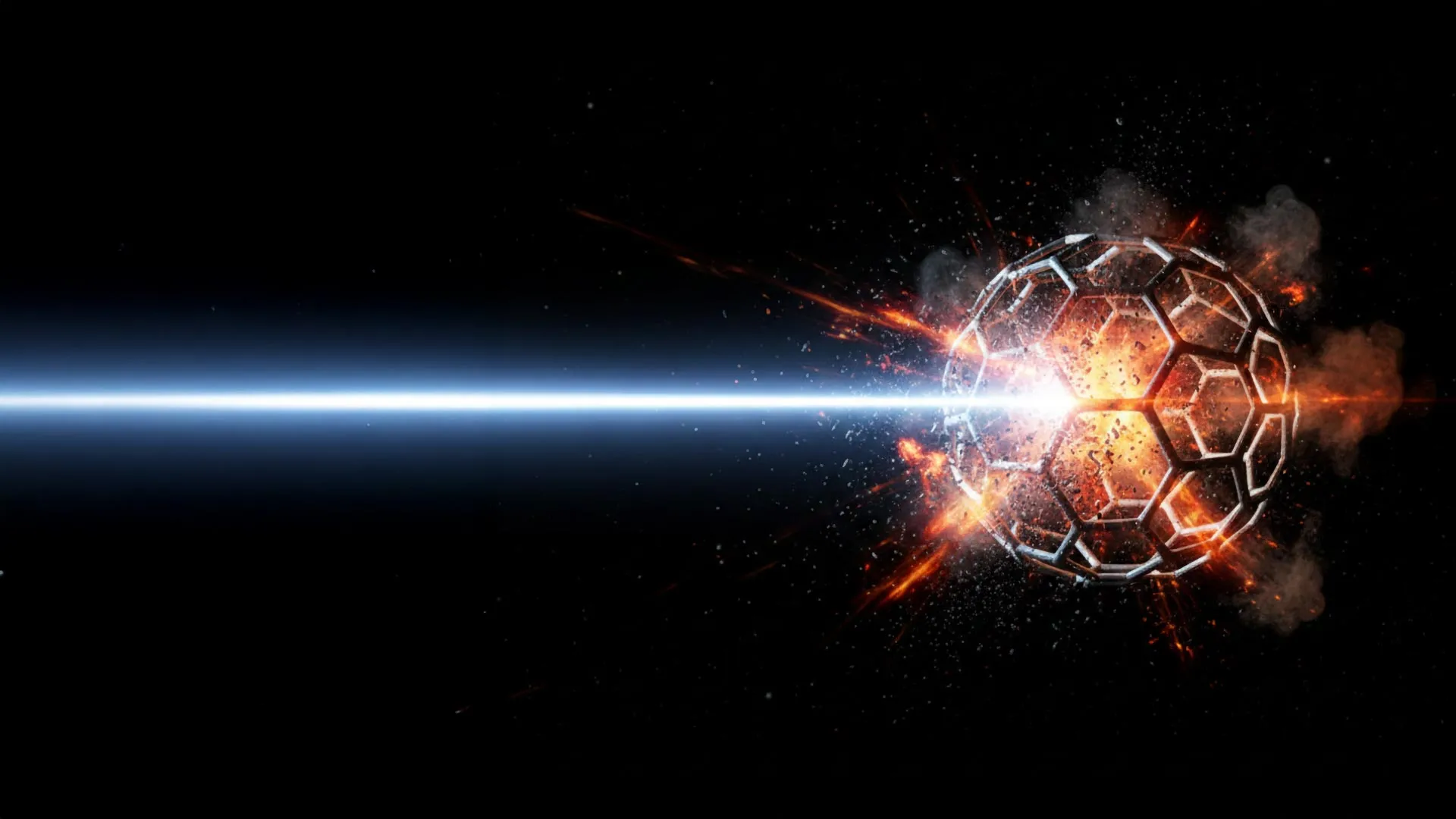X-ray movies reveal how intense lasers tear a buckyball apart
X-rays captured a buckyball breaking apart under powerful lasers, uncovering hidden steps in its rapid collapse.
- Date:
- November 28, 2025
- Source:
- Max-Planck-Institut fur Kernphysik
- Summary:
- Using intense X-rays, researchers captured a buckyball as it expanded, split and shed electrons under strong laser fields. Detailed scattering measurements showed how the molecule behaves at low, medium and high laser intensities. Some predicted oscillations never appeared, pointing to missing physics in current models. The findings create a clearer picture of how molecules fall apart under extreme light.
- Share:

Understanding how many atoms move and interact inside laser-driven polyatomic molecules is essential for any attempt to guide chemical reactions using intense light. With the help of ultrashort, high-power X-ray pulses created by accelerator-based free electron lasers (FELs), scientists can now directly observe how strong laser fields rapidly reshape molecular structures.
To explore these effects, researchers turned to the well-known football-like molecule "Buckminsterfullerene" C60. Teams from the Max Planck Institute for Nuclear Physics (MPIK) in Heidelberg and the Max Planck Institute for the Physics of Complex Systems (MPI-PKS) in Dresden, working with collaborators at the Max Born Institute (MBI) in Berlin as well as groups in Switzerland, USA and Japan, studied C60 experimentally and theoretically. Their experiment at the Linac Coherent Light Source (LCLS) at the SLAC National Accelerator Laboratory produced the first direct images of how C60 behaves when exposed to strong laser fields.
What X-Ray Diffraction Reveals About Molecular Change
To interpret the molecule's response to a strong infrared (IR) laser pulse, the research team analyzed the resulting X-ray diffraction pattern. From this pattern they extracted two key parameters: the (average) radius R of the molecule and the Guinier amplitude A. The Guinier amplitude reflects the strength of the X-ray scattering signal and depends on N2, which is the squared (effective) number of atoms acting as scattering centers. While R tracks expansion or deformation of the molecule and its fragments, A provides insight into fragmentation, including how large or small the resulting pieces are.
At low intensity, the molecule first expands before noticeable fragmentation begins, which is reflected in a delayed and modest decrease in the Guinier amplitude. At intermediate intensity, the expansion stage is followed by a reduction in the radius observed in X-ray images. This shift indicates scattering from smaller fragments and aligns with the slightly delayed drop in the Guinier amplitude, confirming that many molecules have already broken apart.
Rapid Electron Loss at the Highest Laser Power
At the highest intensity, the molecule expands quickly while the Guinier amplitude drops at the very beginning of the strong laser pulse. This sudden change shows that nearly all outer valence (binding) electrons are stripped away early in the interaction. The model calculations reproduce this fast and forceful response, supporting the idea that the molecule experiences a violent "kick" from the laser field.
For low and intermediate intensities, the theoretical model captures only part of the experimental behavior. The model forecasts oscillations in both radius and amplitude caused by a periodic "breathing" motion of the molecule (see movies), yet this motion is entirely absent in the measured data. When the scientists added an ultrafast heating mechanism affecting atomic positions, the revised model more closely matched the experiment. This result shows that both experimental and theoretical work must continue in order to accurately describe how molecules respond to intense laser fields.
Understanding how multiple electrons move under strong laser exposure remains difficult because a complete quantum mechanical treatment is still out of reach for such complex systems. X-ray movies like the ones captured for C60 provide an important testing ground for exploring fundamental quantum processes in increasingly large and intricate molecules. These insights support long-term efforts to guide chemical reactions with precisely shaped laser fields.
Story Source:
Materials provided by Max-Planck-Institut fur Kernphysik. Note: Content may be edited for style and length.
Journal Reference:
- Kirsten Schnorr, Sven Augustin, Ulf Saalmann, Georg Schmid, Arnaud Rouzée, Razib Obaid, Andre AlHaddad, Nora Berrah, Cosmin I. Blaga, Christoph Bostedt, Manuel Cardosa-Gutierrez, Gabriella Carini, Ryan Coffee, Louis F. DiMauro, Philip Hart, Yuta Ito, Katharina Kubicek, Yoshiaki Kumagai, Jochen Küpper, Yu Hang Lai, Hannes Lindenblatt, Ruth A. Livingstone, Severin Meister, Robert Moshammer, Koji Motomura, Thomas Möller, Kaz Nakahara, Timur Osipov, Gaurav Pandey, Dipanwita Ray, Francoise Remacle, Daniel Rolles, Jan Michael Rost, Ilme Schlichting, Rüdiger Schmidt, Simone Techert, Florian Trost, Kiyoshi Ueda, Joachim Ullrich, Marc J.J. Vrakking, Julian Zimmermann, Claus Peter Schulz, Thomas Pfeifer. Visualizing the strong field–induced molecular breakup of C 60 via x-ray diffraction. Science Advances, 2025; 11 (47) DOI: 10.1126/sciadv.adz1900
Cite This Page: